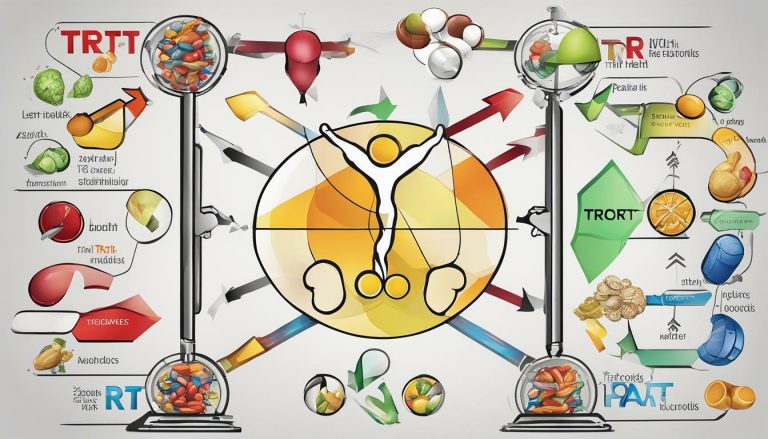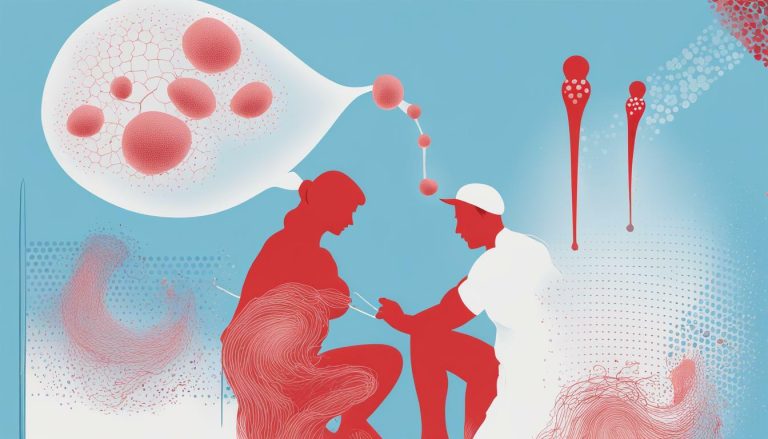Guide on How to Wean Off Inhaled Steroids – Know Your Steps
If you’re using inhaled steroids to manage asthma or other respiratory conditions, it’s important to wean off them gradually to avoid any potential side effects. Weaning off inhaled steroids involves a careful and safe reduction in dosage over a specific period of time.
It’s crucial to understand the steps involved in this process and seek the guidance of a healthcare professional to ensure you reduce your dosage in a controlled manner while still managing your symptoms effectively. Here are some tips for tapering off inhaled steroids and reducing inhaled steroid usage safely.
Key Takeaways
- Weaning off inhaled steroids requires a gradual reduction in dosage over time to avoid side effects.
- A healthcare professional should be consulted to develop a personalized weaning plan.
- Monitoring and evaluation of the progress during the weaning process is crucial.
- Lifestyle changes and non-drug approaches can support the weaning process.
- Potential challenges faced during the weaning process can be overcome with proper strategies.
Understanding Inhaled Steroids and Their Role in Asthma Management
If you have been prescribed inhaled steroids as part of your asthma management plan, you may wonder about the importance of weaning off asthma medications. Inhaled steroids are a type of preventer medication that helps reduce inflammation and swelling in the airways, making it easier to breathe. While they are effective in managing asthma symptoms, long-term usage of inhaled steroids can have potential side effects, such as weakening of bones and increased risk of infections.
It is vital to work with your healthcare professional to develop an individualized plan to wean off preventer medication if possible. In some cases, weaning off inhaled steroids may not be recommended or safe, and your healthcare professional will guide you on the best course of action.
When weaning off preventer medication, it is essential to do it gradually and under medical supervision. Abruptly stopping inhaled steroids can cause a rebound effect, where asthma symptoms worsen temporarily.
Weaning Off Preventer Medication in Asthma Management
Tapering off inhaled steroids is an effective way to minimize the risk of experiencing adverse effects and withdrawal symptoms. It involves gradually reducing the dosage while maintaining control of asthma symptoms.
Working in partnership with your healthcare professional, they will help you develop a personalized weaning plan that will take into account factors such as your asthma severity, current symptoms, and medical history. Making gradual changes will enable your body to adjust to the decreased dosage and help to minimize the risk of experiencing withdrawal symptoms.
The weaning process may take several weeks or even months. Your healthcare professional will monitor your progress and adjust the weaning plan as necessary.
Working with a Healthcare Professional to Develop a Weaning Plan
If you are considering weaning off inhaled steroids, it is important to work with a healthcare professional to develop a personalized weaning plan. This will ensure that you are reducing your dosage safely and avoiding any potential complications.
The steps involved in developing a weaning plan may vary depending on individual circumstances. However, in general, it involves gradually reducing the dosage of inhaled corticosteroids over a specified period of time. This may involve switching to a lower-dose inhaler or using a spacer device to help deliver the medication more effectively.
During the weaning process, your healthcare professional will monitor your symptoms and adjust the dosage as necessary to ensure a smooth transition. It is important to follow their advice and attend regular check-ups to ensure that your condition is properly managed throughout the weaning process.
It’s essential to note that weaning off inhaled steroids should be done gradually to avoid any potential withdrawal symptoms or a possible exacerbation of your asthma symptoms. Your healthcare professional will be able to provide you with guidance and support to make the process as smooth as possible.
Steps for Gradual Withdrawal of Inhaled Steroids
The following are general steps that may be involved in developing a weaning plan for inhaled steroids:
- Consult with a healthcare professional: Before starting the weaning process, consult with a healthcare professional to discuss whether it is appropriate for your individual circumstances.
- Assess your asthma control: Your healthcare professional will assess your asthma control and determine whether you are a suitable candidate for weaning off inhaled steroids.
- Develop a weaning plan: Your healthcare professional will work with you to develop a personalized weaning plan, including a timeline for reducing your dosage and monitoring your symptoms.
- Gradually reduce the dosage: The weaning process involves gradually reducing the dosage of inhaled corticosteroids over a period of weeks or months.
- Monitor your symptoms: Throughout the weaning process, it is important to monitor your asthma symptoms closely and report any changes to your healthcare professional.
Transitioning Away from Inhaled Corticosteroids
Transitioning away from inhaled corticosteroids can be challenging. However, with the help of a healthcare professional, it can be done safely and effectively. In some cases, it may be necessary to use alternative medications or non-drug approaches to manage your asthma symptoms.
It is important to take a proactive approach in managing your asthma and seeking professional advice to develop a safe and effective weaning plan. By doing so, you can reduce your reliance on inhaled steroids and maintain good asthma control in the long-term.
Monitoring and Evaluation during the Weaning Process
As with any medication adjustment, it is essential to monitor and evaluate the progress during the weaning process to ensure a safe and effective transition away from inhaled steroids.
One important aspect of monitoring is to keep track of any withdrawal symptoms that may arise. These symptoms may include shortness of breath, wheezing, coughing, or chest tightness. If any of these symptoms persist or worsen, it is crucial to seek medical attention immediately.
A healthcare professional may also request periodic lung function tests to measure breathing capacity and detect any changes. This testing can help determine if the weaning process is proceeding at an appropriate pace or if adjustments need to be made.
| Steps for Monitoring and Evaluation | Reasoning |
|---|---|
| Keep a written record of symptoms, medications, and doses | Helps identify any patterns or changes over time. |
| Check in with a healthcare professional regularly | They can assess progress and adjust the weaning plan as necessary. |
| Report any changes or concerns immediately | Early intervention can prevent complications or the need for additional medical intervention. |
Gradual discontinuation of inhaled steroid treatment can be a safe and effective process when done under the guidance of a healthcare professional. Proper monitoring and evaluation can ensure a smooth transition and minimize the risk of any adverse effects.
Lifestyle and Non-Drug Approaches to Support Weaning
When it comes to weaning off inhaled steroids, there are various lifestyle changes and non-drug approaches that can aid in the process. These safe methods to reduce inhaled steroid usage can help minimize withdrawal symptoms and support a more gradual tapering off of the medication. Here are some tips:
- Maintain a healthy diet: Eating a balanced diet rich in nutrients can help support lung function and mitigate potential side effects of weaning off inhaled steroids.
- Regular exercise: Engaging in regular physical activity can help improve lung function and reduce the risk of asthma attacks. However, it’s important to consult with a healthcare professional prior to starting any exercise regimen.
- Stress management: Stress can trigger asthma symptoms, so practicing stress-reducing techniques such as deep breathing, meditation, and yoga can be beneficial.
- Alternative therapies: Some alternative therapies, such as acupuncture and herbal remedies, have been found to have benefits for asthma management. However, it’s important to consult with a healthcare professional prior to using any alternative therapies.
It’s important to note that lifestyle changes and non-drug approaches should not be used as a substitute for proper medical treatment. They should be used in conjunction with a healthcare professional’s recommendations for reducing inhaled steroid usage safely and effectively.
Potential Challenges and How to Overcome Them
Weaning off inhaled steroids can be a challenging process, and it is important to be aware of potential withdrawal symptoms. Some common challenges include…
- Rebound asthma symptoms
- Irritation in the throat or mouth
- Difficulty sleeping
- Overall feelings of discomfort and unease
While these effects can be uncomfortable, they are typically short-term, and there are strategies to mitigate discomfort. It is essential to work with a healthcare professional to monitor symptoms and determine the most effective approach for a safe transition.
One strategy is to gradually reduce the dosage of inhaled steroids over time, giving the body time to adjust. Another approach is to use alternative methods to manage asthma symptoms, such as breathing and relaxation exercises. Using a peak flow meter to monitor lung function can also be helpful to avoid worsening symptoms.
If symptoms do become difficult to manage, it may be necessary to increase the dosage of inhaled steroids temporarily. Again, it is essential to consult with a healthcare professional before making changes to any asthma management plan.
“It’s important to note that every person’s experience when weaning off inhaled steroids will be different. Working with your healthcare professional is the best way to ensure a safe and effective transition.”
Conclusion
Gradually reducing the use of inhaled steroids is an essential step towards safe and effective asthma management. Seeking professional medical guidance is crucial as healthcare professionals can provide a personalized weaning plan and monitor the process closely.
Following the steps for gradual withdrawal of inhaled steroids can help minimize potential withdrawal symptoms and ensure a safer transition. It is important to remember that weaning off inhaled steroids should be done under the supervision of a healthcare professional.
By incorporating lifestyle changes and non-drug approaches, the weaning process can be supported, making the transition easier and less challenging. It is important to remain patient and committed throughout the process for optimal results.
Takeaway
If you are considering weaning off inhaled steroids, it is crucial to seek professional advice and follow a personalized weaning plan. Gradual withdrawal of inhaled steroids, along with lifestyle changes and non-drug approaches, can help make the process smoother and safer. Remember to stay committed and patient throughout the process for successful outcomes.






